
 |
|---|
In 1974 I made my first sojourn to Steel Guitar Convention in St. Louis. It was there I met the folks from Sierra steels, and saw their magnificent new guitar. It was a revelation. Modular pick-ups. Folding legs. Machining not to be believed. I said to myself, "That's the first one I've seen which I couldn't build," and I ordered one-- a single-14. A few months later I got a note from them saying the guitar was almost ready, but there were some small problems in that Chuck Wright had left the company, and had enjoined them from using the name "Sierra." Did I mind if there was no name-plate? Then I got a letter from Chuck disowning all connections with the company. Then I got the guitar.
It was terrible. Stiff and grinding. I called Sierra. "Send it back," they said, "we'll work on it." With great trepidation I sent it back and waited. It finally came back, marginally better.
I played with the mechanics some and got it a bit smoother. I re-fashioned the two vertical knee levers into a configuration that Sierra then adopted. Since there was no identification on the guitar, and it was the only single-14 they had made, I made a label with a cartoon bird playing a steel, with a banner underneath that said "Rara Avis" -- Latin for "rare bird." It is this guitar I am playing in the photo on page 76 of the Oak book.
A machinist friend looked at it and asked me what I paid for it. I told him. "Hell," he said, "it would cost that much just to polish all those parts like they are! How do they stay in business?" My reply? "They didn't."
Before I went out to St. Louis in 1975, I got a phone call from Sierra. They had reorganized, and wanted a single-14 to show. I had the only one. I brought it out, and they agreed to take it back and "get it right." When I finally got it back it had been worked on by Chuck Wright himself. He said that the entire changer unit had been installed crooked. It now played like a dream. And it said "Sierra" on the front.
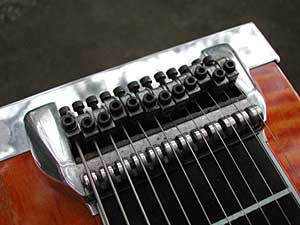 |
|---|
In 1976 while at St. Louis, I met Joe Kline. Joe was making a really nice steel, but I was most impressed with his keyless tuner .
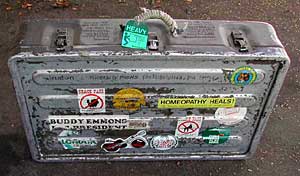 |
|---|
Many years earlier I had bought an army surplus molded aluminum case . It had been used in the Korean War to air-drop medical supplies, and was completely water tight. I bought it thinking that at some time in the future I might make a steel guitar that could fit in that case.
And now there was Joe with his keyless tuner. The very short steel was a possibility. Joe consented to sell me a keyless unit, and I began to think about modifying The Steel.
By this time, George Sell had made a number of modifications to his guitars, and I decided to adopt them to mine. It would mean re-machining the end plate, making some modifications on the changer, and re-doing the entire undercarriage.
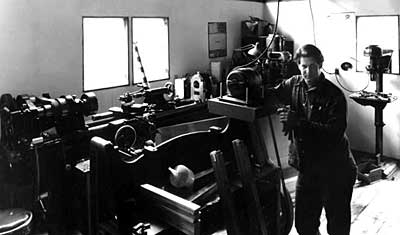 |
|---|
 |
|---|
This time, I made drawings and planned it all out. I took the guitar apart and went to the machine shop of my friend John Bringe (the inventor of the Bringe Banjo capo)-- which had the capability of working to the accuracy I needed for some of the modifications.
I drew the line on the body and approached the band-saw. "This is it!" I said, and pushed the body through. Off came six and a half inches of the left side.
I continued with the modifications; I added the keyless tuner , George's modified changer, and a completely new undercarriage and pedals. George Sell made a new pickup for me. |
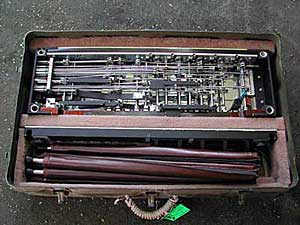 |
|---|
Then I went to work on the army case. The steel fit in it like a glove.
 |
|---|
One of the things I included was an ebony-handled tuning wrench that screwed into the body right by the end of the changer. Nice to have the wrench right-handy!
I re-assembled The Steel, and sold the Sierra.
It was a joy to travel with. It weighed just under the limit for aircraft baggage. "What's in there?" "A musical instrument." "We can't insure it." "Don't worry," said I, thinking "I dare you to damage it!"
And here is the whole thing together!
|
It was the rebuilt steel I used on my solo album, "Steel Wool," for Philo Records.
In July 1979 I was visiting Joe Kline. I told him that I might not play at St. Louis that year because The Steel was getting old, and some return springs needed replacing. Joe's wife, Opal, said, "What would it take to get you to play one of ours?" Well, I had avoided playing any brand except the one I built myself. I was writing reviews of steels for the Pedal Steel Guitar Newsletter, and wanted to maintain my integrity by not being "brand loyal" except to myself. But the Kline was a nice guitar. "You're already playing a piece of a Kline," said Opal.
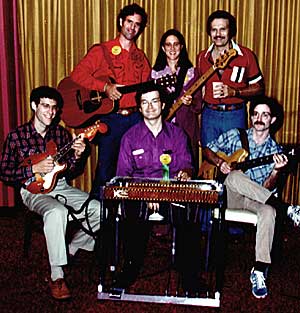 |
|---|
So I told Joe that I'd play a Kline at St. Louis if he made one with my tuning and one that fit me, since my steel sits about an inch lower than "standard." We went to his workshop, and measured me up and figured where all the knee levers were to go. I really wanted it to be a wood finish, but he didn't have any wood that was fancy enough. However, I did! I had three pieces left over from making The Steel, and I shipped them to him.
The Kline was delivered to me in St. Louis on Friday, and I played it at noon on Saturday. I tried to play material that was pretty standard, about which I didn't have to think too much. Keep it simple, and play well. I guess I did. After the show, Joe told me that I sounded so good, he sold all eight guitars he came with. I got to keep the one he made.
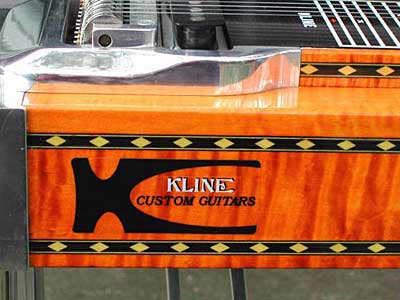 |
|---|
I did some modification of the knee levers, adding "flags" to the two left knee left levers so I could reach them while sitting in my usual position. Other than that, I have hardly touched it. I added a change to a knee lever a few years ago, but that's been it. Haven't touched any of the tuning screws since I got it. Keep the string gauges consistent, and the thing is always in tune.
I made a small modification to the logo. Joe had always used a white logo because all of his guitars had a dark finish. When he finally made a white Formica covered one, he got in some black logos.
I peeled off the white logo and replaced it with the black one. Then I cut the word "Kline" from a white logo and placed it, slightly offset, on top of the black logo-- giving the name a "shadow." Looks pretty good !
The Kline I have has stainless steel changer fingers rather than aluminum, which might account for its "brightness."
So I put The Steel away, and began using the Kline. It played better, sounded better, and was a bit lighter to carry.
I really like it. Here's a description of the Kline mechanism.
When I came to NZ to spend six months in 1993, I brought the Kline with me. When I returned to the states, I left the Kline in NZ, figuring I can always play The Steel again. When I got back and took it out, I was amazed. It played well. And it sounded great! I had always felt that the sustain and tone of the guitar left a lot to be desired. It turned out that the true place the sustain and tone resided was in my hands. And after playing the Kline for the last ten years, I had finally learned how to "make tone."
When I played last in St. Louis in 1996, I brought The Steel with me-- since it travels so well. After my set, Jerry Fessenden, who makes a fine pedal steel, came up to look at the guitar. "Oh. It's a push pull. What kind of pickup?" I told him it was hand wound by George Sell. "It's not fair," said Jerry. "Its a hand-made old push pull with a hand made pickup, and it sounds so good!"
Now that deserves a few strokes!
Amplifiers: I started with a Fender Vibrolux when I had the Sho-Bud. I eventually traded it in on a Sho-Bud single channel that was made by John Cain. It was a great amp-- turn all the knobs to the right, and play!
In 1981 I played through a Peavey Session 500 at St. Louis. It was great. I bought one after the show from Scotty, and took it home. I heard stuff through that amp I never heard before. But it was too heavy to lug around. For smaller gigs, I bought a PolyTone 12" with reverb. It did well.
When I moved to NZ in 1995 I sold both the Peavey and the Sho-Bud and bought a Peavey Nashville 400 that I modified for 240V when I got to NZ. For the times before I permanently settled, I was using a New Zealand made Jansen amp that was modified for steel guitar.
Bar: I started with a regular 7/8" Sho-Bud bar. When I got the S-14, I made a stainless bar that was a little longer. When I went back to The Steel, someone gave me a 1" diameter hard chrome plated bar. I tried it and I loved it. The final call was made by Rick and Lorraine Lee when I was playing a show with them. We did two identical sets back to back. I played the first set with the 7/8" bar, and the second set with the larger bar. When we were done, Rick asked, "What did you change on your amp for the second set? It was so much smoother and clearer." Been using the big bar since!
Picks: I started with Nationals (what I used on the banjo) but I felt they were too stiff. I found Dunlop picks and experimented and decided the .015s were just right. For a thumb pick I use a blue nylon pick. Have to go through a box of them to find a few that fit right.
Volume pedal: I started with a Sho-Bud pedal. When I sold the Sho-Bud, the pedal went with it. With The Steel I had modified the pedal board to accept an Emmons pedal, as seen on the cover of my book. I also had an MSA light beam pedal that I lent to someone and it never came back. Grrr....
In 1974 I got a Goodrich light beam pedal that was also a "wah-wah." I think they made only one or two.
I then got a Goodrich 122-VE pot pedal with a fuzz unit, and then a Goodrich 120 plain pot pedal.
At present, I'm using the Goodrich light-beam-- although I need a small inverter to get the 110v it needs work with the 240v we have in NZ.
 |
|---|
Strings: Any ones! Never found a difference as long as I keep to the same gauges. I generally get them from Tom Bradshaw, but I haven't needed any in a while. Get .011 by the dozen, because that's what usually breaks.
Shoes: When I wrote "Pedal Steel Guitar" I mentioned that everyone has their favorite shoes to play in and I like playing in my favorite pair of cowboy boots. By 1985 I decided that cowboy boots were not good for my feet, so I started wearing Reeboks, and played with them.
While at a seminar with Joe Wright in Australia in 2002, Joe commented on "footwear" and said, "Anything is good except (and he looked straight at me, and grinned) cowboy boots!" Well, at least one person read the book!
I've known people who loved playing barefoot. I've gotten used to playing with the "Ug Boots" that I've been wearing as of late. And I've even played in my "dinosaur" slippers. Anything goes-- as long as you can maintain control and have flexibility of the ankle.
For more information about pedal steel guitars check out these links:
To hear steel guitar, 24 hours a day, 7 days a week, go to Steel Radio.